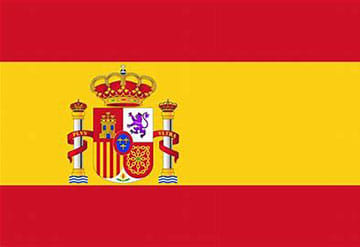The word “ultra” comes from Latin, and has made its way into Spanish as a prefix meaning “excessive,” “extreme,” “exceeding,” or “beyond.” It gives us words like ultrasonido (ultrasonic), ultravioleta (ultraviolet), ultraderecha (for “far right” extremists), and ultramaratón (ultramarathon). But its most prestigious role is on the coat of arms displayed on the Spanish flag, where the Latin phrase PLUS ULTRA (“further beyond”) is written on the banner decorating the pillars flanking the crest.

Figure 1: The flag of the Kingdom of Spain.
The pillars on either side of the coat of arms represent the Pillars of Hercules that mark the entrance to the Mediterranean Sea at the Strait of Gibraltar on the African and Spanish sides. The phrase NON PLUS ULTRA (“nothing further beyond”) used to be written on the banner to indicate that the world ended beyond the borders of the pillars. But when Columbus made it to the American continent, the NON was removed, and the phrase PLUS ULTRA (“further beyond”) was adopted as the personal motto of the Holy Roman Emperor Charles V. Today, it is the official motto of the Kingdom of Spain.
They’re called the Pillars of Hercules, but these “pillars” are actually promontories flanking either side of the Strait of Gibraltar. If you’re traveling out of the Mediterranean Sea into the Atlantic Ocean, the one on your right (the European side) is the Rock of Gibraltar (which was called Kalpe or Calpe in those days), rising 424 meters above sea level. That one is undisputed—but there are two potential candidates for the left pillar on the African side, known as Abila or Abyla. It may be Jebel Musa in Morocco, which rises 840 meters above sea level, or Monte Hacho at 180 meters in the Spanish autonomous city of Ceuta.

Photo 1: The Strait of Gibraltar from the NASA Earth Observatory
Another interesting fact about the Strait of Gibraltar is that Atlantic bluefin tuna arrive there in spring as they head towards the Mediterranean Sea in search of spawning grounds. Once they’ve laid their eggs, they then pass back through the strait and return to the Atlantic Ocean. When they do, Spanish fishermen use fixed nets set up near the shores to capture them. This ancient fishing technique, known as almadraba, has been around since Phoenician times—and there are even written records of it left by Strabo, a geographer and historian who lived during the Age of the Romans. Today, much of the tuna is frozen and exported to Japan, so if you’ve had tuna sashimi in Japan, there’s a good chance it came from the Mediterranean Sea. I’ve posted on this before, so if you’re interested in learning more, you can read the article here: https://kc-i.jp/en/activity/kwn/yamada_s/20150528/
Let me get back on track, but the image of the Pillars of Hercules isn’t just found on the Spanish flag and coat of arms—it’s also recognized around the world as the symbol for US currency, the American dollar ( ). (Most computers only show it with one vertical bar ($)).
It is thought that the first appearance of this symbol in the world’s currency was on the eight-real silver coin (real de a ocho). These coins gained widespread use as legal tender in the Americas as silver dollars, which led to them also being called “Mexican dollars.”

Photo 2: An eight-real coin minted in Mexico during the Spanish colonial period. The face shows the profile of Charles III, with the Spanish coat of arms featuring the Pillars of Hercules on the reverse.
Spain now uses this same coat of arms on its national flag. Incidentally, the red on the flag is said to represent the blood of those who risked their lives to protect the nation, while the yellow is said to represent gold, a symbol of wealth. It’s a compelling explanation, but the fact is that Charles III selected these colors in 1785 for an extremely practical reason: the design would be unmistakable to both friends and foes during naval battles. When you compare the elaborate Spanish coat of arms to the simplicity of Japan’s chrysanthemum crest, you can’t help but recall the famous line, “East is East and West is West.”

Figure 2: The coat of arms of the Kingdom of Spain
That said, while Japan tends to obsess over its written characters, the font used on the cover of the Spanish passport is incredibly simple. The Japanese passport, meanwhile, goes as far as writing the characters for “Japan Passport” in the old, elaborate tensho-style script. Perhaps they were trying to maintain consistency with the look of the State Seal of Japan, which is embossed on all important national documents.

Photos 3

Photos 4
Photos 3 and 4: A Spanish passport bearing the national coat of arms and a Japanese passport with the sixteen-petal chrysanthemum seal. The red one is an ordinary passport good for ten years, while the dark-blue one is an ordinary passport valid for five.






























































